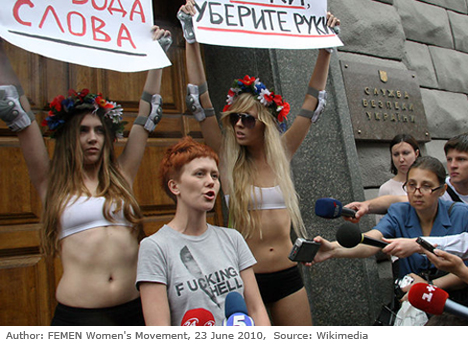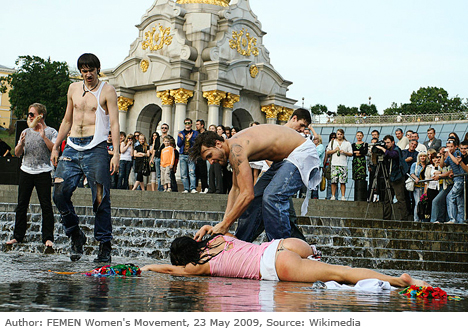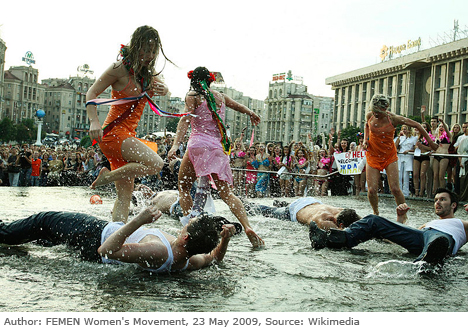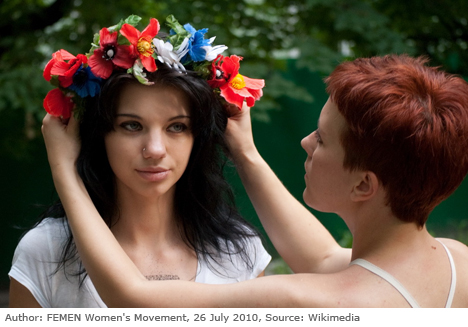Ukraine’s transition from totalitarianism to a market-driven society began in 1991. On 24 August that year, the country was on the cusp of an epiphany – its successful declaration of independence. With it, the nation’s women began to embark on the process of distancing themselves from their Soviet past. Seeking to authenticate their ethnic uniqueness by rejecting the collective, quasi-masculine Soviet model of quintessential womanhood, Ukrainians reached back into prehistory for a lasting symbol of Ukrainian cultural identity – and found the legendary “hearth mother” Berehynia, signifier of women’s empowerment and Ukraine’s historically matriarchal society.
Berehynia’s image was de-contextualized and reinserted into different structural-historical circumstances, projected onto the contemporary culturally-determined female stereotype to reanimate the ancient paradigm of the ideal woman. Berehynia thus came to exemplify both the empowered “domestic Madonna” and her modern, “mother of the nation” counterpart. References to Berehynia flourished, lulling Ukrainian women into a false sense of centrality, serving only to elevate men even further to a perceived position of superiority.
During that first wave of rejection of the dominant values of communist ideology, not all women in Ukraine were content to identify with the neo-traditional image of femininity, although the cultural connection was strong and difficult to reject. Some opted for a vision of Ukrainian women that signified western-style “sophistication”. Along a continuum of rejected societal norms, a kaleidoscope of lifestyles contributed to the early formation of a new model of female identity. This departure from the stultifying collective past projected a sense of individuality and personal freedom – an important psychological distancing from the common herd.
The reforming objectives, however, contained a fatal weakness. In the prevailing conservative post-Soviet environment, a great many women, often including the reformers themselves, still seemed unable to grasp the full significance of the hegemonic patriarchal culture of the transitional world in which they now lived. They still seemed to see themselves as lesser beings whose role was to support a male dominated system of power that mediated their subordination by persuasion, through an effective process of acculturation. Ukraine is laden with such historical baggage, the result of which is that gender inequality has proven to be much more intractable than originally anticipated. This has inhibited meaningful change.
A major source of weakness in promoting women’s rights was women’s own world view. With a few exceptions, the first wave (or proto-) feminists applied their energies to lobbying for short-term gains, making repeated appeals for the creation of conditions that would allow special concessions for women. They emphasized their desire for the reconciliation of women’s professional and maternal obligations – the latter an environment where “women could be women”. A pervasive cult of essentialist motherhood, cloaked as a call for the redress of sexual inequality, obscured the need for a more effective paradigm of womanhood and gender parity. References to women’s essential qualities and an almost mechanical belief in the power of intention to determine policy inhibited both the scale and pace of reforms.
Notwithstanding the undeniable – if limited – advances in eradicating gender-based discrimination achieved by the pioneer reformers, many of their important goals remain unfulfilled. Their uphill struggle to eliminate negative stereotyping and the continued exploitation of women has shown how intractable genuine reform can be. Before long, feminists were faced with the hard fact that building a large-scale pressure group with real transformative possibilities requires prolonged struggle, and that failure must always be considered a possibility.
The new wave: FEMEN
Any emergent social movement will faces obstacles, will proceed unevenly and with difficulty as it undermines people’s resistance toward cultural change. In Ukraine, the decades ahead will present ever greater challenges to the formation of a consensus on women’s rights, even as people’s awareness of the patterns of anti-woman discrimination increases. In the pursuit of gender justice, the one important thing to bear in mind is that, periodically, a cause must reinvent itself if it is to remain relevant to the requirements of the times. This is especially true in the fluid political atmosphere of contemporary Ukraine.
To extend and strengthen the level of collaboration, organizations committed to protecting and promoting women’s rights have begun to form; but many more are needed if Ukrainian women are to transcend the patriarchal constraints under which they live. The blatantly sexist administration in power since 2010, its values rooted in the dominant hegemonic patriarchy, presents severe impediments to gender justice, although it is not inconceivable that at some juncture its coercive measures will miscarry and inspire fierce resistance. As advocates of women’s rights take stock of their progress over the past two decades, they are realizing that the time is ripe for taking resistance to a higher plane.
In this state of new awakening, politically radicalized gender activists rose to prominence in Ukraine as early as 2008. They ushered in the beginnings of a new wave of opposition to the post-Soviet value system, rooted as it is in the neo-traditional views of women that replaced earlier communist ideals. In the words of Dorothy L. Hodgson and Ethel Brook, “age emerges as a fascinating dynamic location that shapes the modalities of activism”. It was the various youthful groups that were the ones to rise to the challenges left unmet by the previous generation, notwithstanding the latter’s best efforts. Current examples of disaffection are various, but they have one thing in common – they increasingly tend to be the actions of young people exhibiting radical shifts away from the views of the past. The new wave feminists now insist upon an increasingly proactive role in advocating solutions to social problems.
 By the spring of 2008, Ukraine’s initial post-Soviet status quo was facing the prospect of being dethroned. This rearrangement began to loom in 2007, in the wake of a year-long, UN-sponsored, nationwide public information campaign titled “Ukraine 2015”. Although still in its declarative stage, change was clearly in the air. Riding the crest of this reforming surge, a unique (for Ukraine) cohort of activists – in the form of a grassroots organization of university students in Kyiv calling itself FEMEN – began its ascent to prominence, redefining the nature of public dissent. The organization turned to subversive parodies designed to destabilize a corrupt power structure. Unlike its predecessors, this postmodern group of radicalized young women had matured in an open, democratizing society. Visiting Bethlehem in 2007 on an exchange programme for leaders, Anna Hutsol came away persuaded that if the changes that were so desperately needed were to translate into reality, the women themselves would have to take the initiative and become the agents of their own transformation.
By the spring of 2008, Ukraine’s initial post-Soviet status quo was facing the prospect of being dethroned. This rearrangement began to loom in 2007, in the wake of a year-long, UN-sponsored, nationwide public information campaign titled “Ukraine 2015”. Although still in its declarative stage, change was clearly in the air. Riding the crest of this reforming surge, a unique (for Ukraine) cohort of activists – in the form of a grassroots organization of university students in Kyiv calling itself FEMEN – began its ascent to prominence, redefining the nature of public dissent. The organization turned to subversive parodies designed to destabilize a corrupt power structure. Unlike its predecessors, this postmodern group of radicalized young women had matured in an open, democratizing society. Visiting Bethlehem in 2007 on an exchange programme for leaders, Anna Hutsol came away persuaded that if the changes that were so desperately needed were to translate into reality, the women themselves would have to take the initiative and become the agents of their own transformation.
Hutsol founded FEMEN in May 2008. A group without organizational or historical antecedents in Ukraine, its motto became “Ukraine is not a brothel” and pink its signature colour. Hutsol’s stated objective was to encourage women to voice their protest against the destructive fallout from the host of injustices women faced. At the same time, Hutsol and her adherents rejected the feminist label (although their cause clearly supported its values). They began with rallies against prostitution, which soon gave way to a series of tongue-in-cheek parodies of misogynistic practices. Using street theatre to simulate physical attack, rape and exploitation of women, protest became for them a realm of play, creating a space for interaction with a wide variety of passersby. Although it would soon become the trademark of their protests, toplessness was initially not part of FEMEN’s dissident profile.
FEMEN built upon the growing quest for gender justice inaugurated by the “proto-feminists”, but opted for radically unconventional forms of dissent from the residue of communist values and the neoconservative configuration that supplanted them. This nonconformist organization succeeded in attracting a core membership of three to four hundred activists, exhibiting a fervent social consciousness and leadership skills capable of successfully challenging government malfeasance and the country’s range of social ills. Hutsol saw this interest group – a frequently pink-clad brigade of what is described as the most radical feminist movement in Europe today – as the precursor to a formal political organization. Her ultimate dream is to found a women’s party and to make it the most influential female political force in all of Europe; for the present, however Hutsol, is concentrating on activism as a preliminary step in building a coalition of women’s rights advocates in Ukraine.


FEMEN’s images and actions became increasingly daring and innovative – scandalous demonstrations, bizarre street theatre and, lately, more overtly political rallies and expressions of civil disobedience. More often than not, the shocking nature of their protests, particularly the notorious spectacles of near-nudity in the public space, is either misunderstood or regarded with suspicion, especially by those lacking the analytical skills to understand the issues being parodied and theatricalized. But, as Hutsol continues to insist, although the tactics might be extreme (and offensive to some), shedding clothes is the most effective measure in the process of drawing attention to FEMEN’s cause, inspiring the public imagination, promoting public discourse about women’s problems, creating social connections, developing networks and alliances, and mobilizing active public support for gender justice.
Although FEMEN’s initial protests were directed against the twin evils of prostitution and trafficking in women, organizers soon added to their agenda sexual exploitation in institutions of higher education. Inasmuch as FEMEN’s membership consists primarily of students, this would appear to represent a natural segue into an expanded protest. Young women, particularly those from provincial universities, had begun to share chilling stories of coerced sex (sometimes leading to suicides) in exchange for admission, government stipends, student housing or decent grades. In a highly publicized drive for accountability and reform, FEMEN’s demonstrators mounted dramatic protests against “sex-for-grades-and-stipends”. One of the most startling displays of opposition to the corruption in institutions of higher learning was a near-pornographic “theatre-of-the-absurd” staged in front of the Ministry of Education, featuring the tension between a resolve to study and its contemptible price in Ukraine’s institutions of enlightenment – the corrupt academe.
This particular street performance portrays a student in the process of submitting an assignment to her professor, whose image invokes that of a pimp more than that of an academic. The student’s provocative stance leaves little to the imagination. To all appearances, a sexually explicit “Faustian Pact” is seemingly being struck. Next to her is the image of another student with a dogged resolve to pursue her studies, even while exposing its obscene price. Her discordant attire can also be read as signifying the incongruity between a notoriously corrupt educational system (with sex the medium of exchange) and an earlier era of decency and respect for scholarship. She is wearing a fashionable miniskirt – reflecting a contemporary trend – offset by red boots and a beribboned wreath – classic markers of a single woman’s traditional folk outfit. The garland also symbolizes a medieval myth of mysterious female powers over men, attributed to legendary wood sprites and water nymphs. Despite the fact that the student is still in possession of her magical wreath, corruption is clearly threatening both her virtue and her ability to proceed with an education. Several interpretations of this image are possible and have been put forth, but what they all come down to is a dichotomy of past and present, its respective values reflecting the nature of society then and now.
Politicization
Even though politics were initially not on FEMEN’s agenda, issues with a less direct connection to women’s problems, and occasionally even no direct connection at all, have become an important target of the group’s opposition to a broken system. On 19 October 2008, for example, protesters stripped down to bikinis and staged a high-spirited mud-wrestling event in front of the ministerial building in a calculated attempt to attract the attention of cabinet members; their message was to bring to light the dirtiness of Ukrainian politics.
As the organization’s media exposure and global popularity rose, the target of FEMEN’s protests shifted from a primary focus on prostitution and Ukraine’s image as a huge brothel towards radical opposition to an expanded array of political, social, and economic issues. Carnivalesque attire remained in evidence, but by 2009 FEMEN activists were also topless and street theatre had given way to rallies and a new array of political confrontations.
During Ukraine’s presidential election in February 2010, FEMEN protesters expressed their well-founded fear of the deterioration of Ukrainian politics. On the day of the election, six protesters gained access to the polling station at which Yanukovych was to cast his vote, staging a demonstration against electoral fraud and overall corruption. Except for some blue tape crisscrossing their nipples, the protesters were naked from the waist up. Polling station workers stared in disbelief as the demonstrators unveiled placards, concealed under their coats when they arrived, emblazoned with the words: “Don’t sell your vote! Don’t be a slut!”. “The politicians are raping us”, shouted one of the protesters, while a security man attempted, at first unsuccessfully, to evict the demonstrators. Eventually they were turned out of the building and, once safely out of the range of the cameras, were arrested and charged with the all-too familiar, catch-all offence of hooliganism. FEMEN organizers deemed the incident to have been highly successful, inasmuch as it had attracted widespread media coverage and thereby drawn attention to the political issues that FEMEN were striving to highlight.
Victor Yanukovych won the election by a slim margin and lost no time in filling his cabinet with like-minded, misogynistic, Soviet-era “retreads”. He appointed his closest ally Mykola Azarov (often described as an unreconstructed dinosaur) to the post of Prime Minister. Both men were guilty of inflammatory sexist comments that violated Ukraine’s constitutional guarantees of equal rights. During the runoff election campaign (between Yanukovych and Tymoshenko), the former was heard to remark that his female competitor ought to indulge her whims in the kitchen, where all women belonged. Azarov then contributed his own judgment of women in leadership positions, replying to a question as to why his cabinet was restricted to males by saying: “Conducting reforms is not women’s business.” His comment set off a storm of criticism throughout Ukraine as well as western Europe, while the media stoked the fires with continuing coverage. Patriarchal norms lodge themselves even more securely into such an environment.
In reaction to the sexist comments, and sensing more determined opposition from the newly appointed ministers, FEMEN modified its tactics, temporarily exchanging their trashy image for a conservative look. White shirts and earnest-looking grey trousers replaced their customary semi-nudity when they sought an audience with ministers. Compared with the previous, “more civilized” response from security forces, this time FEMEN confronted a hostile wall of riot police determined to block contact between the two sides. Eventually, the standoff escalated into a shouting and shoving match, with police forcing FEMEN demonstrators to the opposite side of the street, arresting a token protester and once again levelling the customary charge of hooliganism.
In two short years, FEMEN had evolved from a women’s-rights-oriented organization into a radical political opposition to what it perceived as the current administration’s Kremlin-style tactics. Its public activities now included dramatic protests against the curtailment of free speech and democratic liberties. Both FEMEN’s influence and visibility continued to grow, at least for the time being.
What next?
Ukraine’s political landscape is currently being radically transformed, despite the reactionary government of Viktor Yanukovych. The process of challenging the silences and complicities of everyday life has assumed new complexities and greater seriousness. Ukraine’s failure to resolve its social ills under the “Orange regime” brought to the forefront two conflicting forces: an administration tending toward a police state versus and a postmodern generation of radical activists prepared to challenge the creeping authoritarianism of the dominant power structure.
At the end of 2004, Ukraine’s Orange Revolution mobilized masses of young people in a collective response to electoral fraud. Ukraine’s historical moment seemed to have arrived, signalling that consolidated democracy was at hand. Yet, by early 2010, it was evident that the revolutionary euphoria had dissipated, and the Orange leadership had betrayed its revolutionary mandate by indulging in the debilitating infighting. Almost immediately after the previously discredited Victor Yanukovych returned to power, the country began a backward slide towards a Soviet-style authoritarianism. This begs the question whether the present power brokers will succeed in suppressing the youthful enthusiasm of non-conformists such as FEMEN, together with the organization’s goal of engendering a comprehensive democracy. Or will the new political leaders make the same mistakes that so many repressive regimes have made in the past, and by overplaying their hand court the opposition they seek so brutally to suppress?
On 25 February 2010, Victor Yanukovych, that twice-convicted felon, was inaugurated as Ukraine’s fourth president. Exhibiting an almost pathological fear of public criticism, he and his cronies swiftly moved to restrict public assemblies and muzzle the press, often resorting to brutal police tactics to achieve their ends. On 17 June 2010, a rally against proposed legislation that would bar public assemblies without official approval brought hundreds of youthful activists to Kyiv’s central square. They scored a temporary victory but, as subsequent developments would demonstrate, it was a pyrrhic one.

The rally for freedom of assembly followed on the heels of a FEMEN demonstration on 3 June 2010 against limitations on democratic liberties and freedom of the press, timed to coincide with Yanukovych’s first 100 days in office. A month later, on 2 July 2010, FEMEN demonstrations assumed an quasi-international aspect with an audacious breach of protocol, as bare-breasted contingent of FEMEN’s women at St Sophia Square welcomed US Secretary of State Hillary Clinton on the occasion of her visit to the city. Semi-nude, they petitioned her to advocate for women’s rights during her meeting with President Yanukovych. Putin’s visit to Ukraine in November 2011 provided yet another incentive for expanding FEMEN’s dissident politics, this time targeting Russian meddling in Ukraine’s internal affairs. Wearing traditional garlands on their heads and adding Ukrainian flags as adornments, demonstrators chanted “Ukraine is not Alina” – a reference to Putin’s affair with a Russian gymnast, and signifying that Ukraine was not Russia’s mistress.
As FEMEN’s notoriety increased, its targets multiplied and spread abroad, as demonstrators took on broader international issues. This led to arrests (in Turkey and Switzerland among others), and even savage retaliation: three FEMEN protesters in Belarus were brutally abused before being driven naked to the Ukrainian-Belarusian border and abandoned without documents or money.
During the initial months of FEMEN’s existence, Ukrainian authorities appear not to have taken the organization very seriously. By 2011, however, FEMEN was being perceived as a formidable pressure group and its members were becoming increasingly vulnerable to arrest. Earlier, they had simply been taken into custody, charged with hooliganism, and usually released the same day. Now, to quote the FEMEN activist Inna Shevchenko, “they have put a system in place for arresting us” (suggesting serious prison time; she recently spent three days under arrest). The secret service has also been known to make intimidating late-night calls to FEMEN’s leadership, demanding that they suspended collective action or face dire consequences.
The impact of dissent
The question of FEMEN’s enduring viability raises some serious concerns. No matter how powerful the impact of dissidence becomes, sooner or later even the most scandalous expressions of protest lose their shock value and need to be reinvented. Have the activists become precursors of a historical process generating a bold new protest pattern, or has FEMEN been reduced to a cliché, an organization of exhibitionists protesting for the sake of protest? Has FEMEN become a sufficiently effective, relevant vehicle for bringing Ukraine’s mounting problems into the public awareness? Does FEMEN remain a civil disobedience force capable of making a difference today?
In answering these questions, we must bear in mind that the organization generates and answers questions relating to human rights, corruption, gender justice, and Ukraine’s global image as a thriving destination for sex tourists, while lacking a consistent agenda and coherent theoretical foundation. FEMEN is a compilation of several ideological leanings, not the least of which is feminism – although the term is one of such opprobrium in Ukrainian society that its adherents deny it as a self-descriptor. This prompted FEMEN to broaden its agenda to address issues such as vote-rigging and media censorship, not to mention international causes often unrelated to women’s concerns, while its initial mission – raising awareness of the evils of Ukraine’s sex industry and sex tourism, both of which are running out of control – took a back seat. Indeed, since the movement’s inception, prostitution as an industry has expanded exponentially. Initially, FEMEN’s organizers lobbied for a constitutional amendment that would criminalize prostitution. Hope for this has faded since the advent of President Yanukovych. Prostitution is now a lucrative business, too lucrative for the power brokers to consider criminalizing it. Brothel owners are closely tied to law enforcement personnel, and corrupt legislators are said to be profiting handsomely from the proceeds of this illicit trade. In the past year alone, revenue from the activities of the sex-for-hire industry has roughly doubled, from three-quarters to one-and-a-half million dollars. Under the present administration, the political will to outlaw prostitution has even less chance than ever.
Nor has the image of women in the transitional society we call Ukraine improved, despite the modest gains that were made. This was illuminated in a recent parliamentary session, during which MPs debated bringing more women into the political mainstream. In the course of the proceedings, Parliamentary Speaker Volodymyr Lytvyn underscored the popular belief in women’s inferiority with a reference to the biblical account of her formation from Adam’s rib. And what is one to think about the government’s stated commitment to bringing more women into the political mainstream when confronted with reports such as that about the behaviour of MP Petro Melnyk (Party of Regions), who made a violent attempt to eject a female deputy (Irina Herashchenko) from a polling station during the election for City Council Chair in Obukhiv, Kyiv region (along with the comment: “What are you doing here? Decent women are at home sleeping with their husbands”.
The recent, harrowing story of 18-year-old Oksana Makar’s gang rape and murder by fire, with which we must all be familiar by now, also attests to the value placed upon women as human beings. Sadly, it is not unusual to read in the media about the opinions of ordinary citizens, including the mother of one of the perpetrators, Larysa Pohosian, condemning the victim. Like so many others, Pohosian attributed the contemptible conduct of three young men (sons of officials) to Oksana’s own provocative behaviour. This judgment emphasized a popular belief that she got what she deserved as a “loose woman” (not proven). It is an attitude that is not uncommon among Ukrainians: the country has a long history of condoning abuse of women (boys will be boys; girls must answer for their own misfortune when they put themselves in harm’s way). The victim is impugned; she is put on trial by society while the assailant often finds himself being defended. Ukrainian women, those “inferior beings fashioned from Adam’s rib”, are held to a higher standard than “the men whom God allegedly created to rule over them”! This bizarre legacy is played out in another sphere, too: currently, large sums are said to be pouring in for the defence of the sadistic monsters who attempted to immolate this young woman in order to cover up their gang rape. Ironically, this abomination of Ukrainian justice was played out during “Women’s History Month” (March 2012). And it began on the day after International Women’s Day, when Ukrainian women are routinely eulogized as the best, the most desirable, most beautiful, most intelligent in the world.
Sadly, a great many Ukrainian women are still flattered by such public declarations of “esteem”. They provide no hint of understanding that in welcoming this sort of patronizing tribute, they reject their own interests as fully valued human beings deserving of equality and respect. To regard such salutations as something more than a condescending “greeting card” message is to denigrate all women, to infantilize them as subjects requiring the care and protection of “masterful” men. Often, it is the same women who support such saccharine endorsement of their own “femininity” that condemn the behaviour of spirited young women when the latter meet a tragic fate “brought on by their own conduct”.
Before rushing to judgment about the appropriateness of FEMEN’s expressions of protest, as many have done, we might ask ourselves whether there is a more effective way to “market” their messages than resorting to women’s half-naked bodies, bodies that are so often used successfully to market commodities. To be sure, semi-nudity must eventually, inevitably, lose its force as a political statement. For the present, however, it could be the most viable means of generating public dialogue on women’s rights as a preliminary step toward achieving that elusive goal of gender justice. Who is to say that FEMEN is not in the vanguard of cataclysmic changes in feminist thinking, even without styling themselves feminists? That they are not demonstrators swimming against the tide of women’s essentialization and the dominant, hegemonic patriarchal value-system in which they live?
Contrary to the best efforts of both waves of reformers, gender justice in Ukraine has reversed its course and is tending in the opposite direction. An outstanding example of how far this backwards tendency has already moved is to be found in the recent attempt by Ukraine’s male leadership to push through a draft bill outlawing abortion, in the interest of augmenting the country’s declining population! Aside from this blatant violation of a woman’s basic right to choose, such a legislative action carries the potential for severe repercussions, even for the legislators. To offer an extreme illustration, let us recall where such a policy led Nicolae Ceausescu: in 1966, laws were introduced in Romania to engineer an increase in the size of the population. “The foetus is the property of the entire society,” Ceausescu thundered. The birth-rate almost doubled as a result, but it was accompanied by a leap in infant mortality, with the rising numbers of handicapped, orphaned and abandoned children being placed in decrepit institutions under state care. After the fall of Ceausescu in 1989, over 100,000 handicapped and orphaned children were discovered living in horrific conditions. Attempts to introduce an anti-abortion bill in Ukraine have, if nothing else, caused FEMEN to move closer to its original mission of calling attention to specifically women’s causes.
A pink revolution?
Today’s protests are not the actions of a generation schooled in the old-style authoritarian principles of a once-disgraced regime, but rather those of a fearless-seeming, postmodern generation who have come to adulthood with a set of values and proposed solutions to their problems that differ dramatically from those of their predecessors. They know what it means to exist without the ideological constraints that regulated the lives of previous generations. Can youthful movements like FEMEN successfully seek and find solutions to the nation’s problems? Is the average person capable of appreciating the seriousness behind their scandalous tactics? Will their unorthodox means of challenging existing patriarchal values translate into influence, or will the shocking nature of semi-nude protests offend the sensibilities of would-be supporters and detractors alike, and halt progress in the achievement of women’s rights? All are open questions.
Finally, is FEMEN capable of moving from the level of an organization to that of a mass movement? To all intents and purposes, it meets the formal criteria of a movement, as described by Carol Mueller as specific individuals “who have formed emotional bonds from their interaction, negotiated a sense of group membership, and made a plan for change, [creating] a collective identity”. Through devices such as press conferences, slogans, costumes, rallies, political demonstrations, civil disobedience and street theatre, this postmodern generation of radicalized young women is creating a network with the potential to coalesce into a national movement of opposition. Their ability to reinvent themselves will determine their evolution as a social force for change, and their future newsworthiness as a mass movement.










